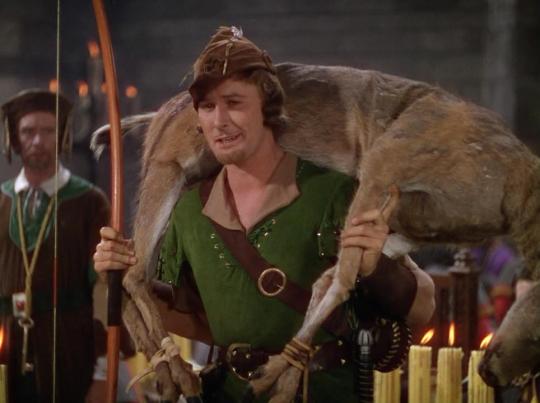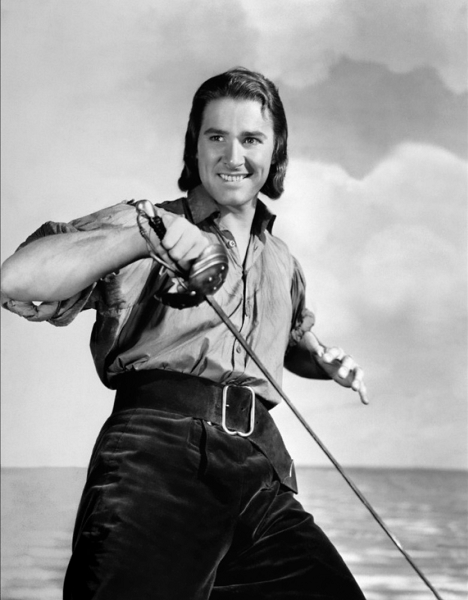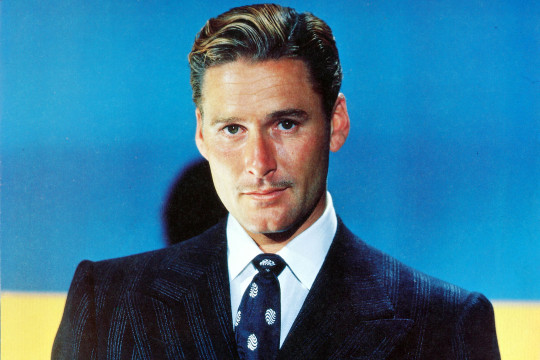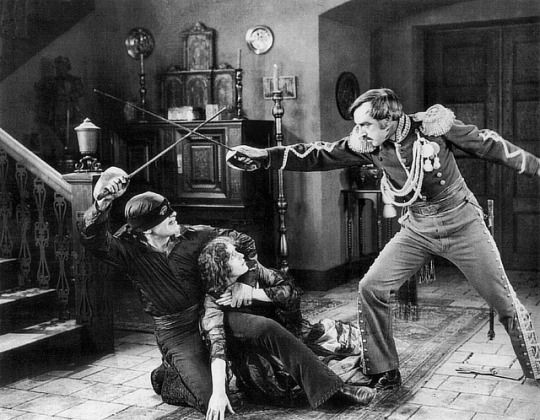In Like Flynn (Only): The Rise and Rapid Fall of the Swashbucklerby Steven Goldman
By Yasmina Tawil

After any viewing of Errol Flynns The Adventures of Robin Hood (1938), one is tempted to say, They dont make em like that anymore. From the perfection of its casting, with Flynn, Olivia de Havilland, Basil Rathbone, Claude Rains, Eugene Pallette, Alan Hale, and Melville Cooper, to its lush score by Erich Wolfgang Korngold, to its unity of tone (despite a midcourse change of directors), to what historian David Thomson called its stained-glass Technicolor, it represents the apotheosis of a genre as well as an exemplar of what the old factory-style studios could deliver when the personnel on staff and the story they were telling found a near-perfect alchemy. However, Robin Hood had only dim antecedents and no successors, so to say, They dont make em like that anymore, isnt quite accurate. But for this one picture, They never made em is closer to the mark.
The swashbuckler genre, that of swords flashing in times ranging from the Dark Ages to the 18th century Caribbean to which Flynns greatest film belongs, began in 1920 when Douglas Fairbanks switched from comedies to action films with The Mark of Zorro. Right in that first picture, Fairbanks and director Fred Niblo established conventions that were repeated in film after film and still recur in cinematic cousins such as the Star Wars movies. The hero is, in the words of Robin Hood co-writer Norman Reilly Raine, a swashbuckling, reckless, rakehell type of character, who is in rebellion against corrupt government authority, but never government authority in generalthe swashbuckling hero is not an anarchist or terrorist, but in many senses a conservative who wants to see power exercised responsibly or by the right people. The hero is an expert with the sword and other weapons, but is also an acrobat, capable of amazing stunts such as riding down a mainsail on the point of a dagger (Fairbanks in his 1926 The Black Pirate). He wins his cause in one on one combat with the villain, usually in a long duel, after which he is often revealed to be a disguised noble, or at the very least forgiven for his trespasses against a government that had lost its way.

Zorro came out of pulp fiction by way of Baroness Orczys Scarlett Pimpernel, but as Fairbanks and others went on to capitalize on the films success, they found additional sources in the novels of Alexandre Dumas (The Three Musketeers, The Man in the Iron Mask, The Corsican Brothers, The Count of Monte Cristo), Rafael Sabatini (Captain Blood, The Black Swan, Scaramouche), Walter Scott (Ivanhoe, Rob Roy), and the pirate and Robin Hood tales of Howard Pyle. Despite the deep well of material to adapt, the run of swashbucklers largely halted with the simultaneous decline of Fairbankshe was 46 in 1929, the year of The Iron Mask, his last genre film and the first in which, as if to underscore the passage of time, he diedand the arrival of sound.
It wasnt just that Fairbanks was now a bit old and somewhat paunchy for an action hero. Other actors might have picked up cloak and rapier, but nascent sound technology made it impractical for a hero to bounce all over the screen while delivering dialogue. As hilariously and accurately recalled in Singin in the Rain (1952), movies were almost back to the fixed camera and proscenium arch style of the early days, when filmmakers couldnt do much more than film plays as staged. Sound rapidly evolved to allow for more dynamic productions. In the meantime, Hollywood reveled in films set in contemporary times that explored sex, crime, and even the odd glimpse of nudityprominent swords gave way to prominent nipples.
Alas, the new candor only lasted so long due to the strict enforcement of the Production Code that began in 1934. Now the studios had to offer clean thrills, which is to say pure romance without innuendo and visceralbut not prurientexcitement. A small handful of successful 1934 filmsMGMs Treasure Island with Wallace Beery as Long John Silver and a too-young Jackie Cooper as Jim Hawkins, independent producer Edward Smalls The Count of Monte Cristo with Robert Donat as the revenge-minded Edmond Dantes, and the Britain-originating The Scarlet Pimpernel with Leslie Howard as the title charactersuggested that public taste would welcome romantic adventure in place of earthier forms of romance.

Warner Brothers entry was Captain Blood. Donat initially committed to taking the title role of an Irish doctor who inadvertently finds himself on the wrong side of an attempt to overthrow King James II and is condemned to serve as a slave in the Jamaica colony, but he withdrew at the last minute for reasons that are still unclear but may have been as simple as a health issue and as complicated as his mistress refusing to spend several months in California. The films producers fantasized about Howard, Fredric March, Clark Gable, and Ronald Colman (the last of whom would later excel in the 1937 swashbuckler The Prisoner of Zenda for David Selznick), and tested Brian Aherne and designated Bette Davis costar George Brent before studio head Jack Warner suggested they try Flynn. The 26-year-old Tasmanian was on the payroll, after all; might as well use him.
In retrospect, its amazing how all the elements of a successful Flynn swashbuckler came together at once, but again, for all the negatives inherent in the studio system, one plus was that it functioned as a huge sorting bin for talent that could be deployed as needed. Flynn and the director Michael Curtiz would be together for years. De Havilland, going on 20, was a film neophyte the studio was trying to establish. She and Flynn would eventually make another seven films together (eight if you count the review film Thank Your Lucky Stars) and tantalize the public with one of the screens great unconsummated but nevertheless real romances. Rathbone is on hand as an antagonist with a deadly sword (something he didnt have to fake), a role he would reprise not just in Robin Hood but in pictures as diverse as The Mark of Zorro (1940) opposite Tyrone Power and The Court Jester (1955) in tongue-twisting battle against Danny Kaye.

And then there was Flynn himself, vaulted instantly to stardom by the picture. The son of a marine biologist and a distant mother he came to despise, Flynn never completed his formal education due to the peripatetic existence required by his fathers career and his own propensity for getting expelled from whatever school his parents placed him in. By the time he was 18, he had worked as a mail clerk and a stevedore, and he competed as an amateur boxer before leaving Australia for New Guinea to prospect for gold. In addition to his efforts to get rich quick, he worked a series of jobs with the islands various tobacco and copra plantations, got into a series of scrapes he would spend the rest of his life embellishing, and somehow, in 1933, ended up playing Fletcher Christian in an Australian film, In the Wake of the Bounty. This seems to have put the idea of becoming an actor in his mind, and that year he went to Great Britain and got work in a repertory theater company. The next year he was the lead in the film Murder at Monte Carlo, a film financed by Warner Bros. to honor British laws requiring a certain percentage of films exhibited in the country must have originated there. Flynns work was promising enough to intrigue the studio (completing a kind of circle, he was recommended by an acquaintance, Douglas Fairbanks, Jr.) and they brought him to Hollywood.
Critics have long considered Flynn a poor actor. If true, this would certainly be unsurprising given his journey from New Guinea knockabout to leading man took a little over a year, with training that consisted almost entirely of the 22 plays in which he performed for the Northampton Repertory Players in England. It was certainly true at times in Captain Blood. Flynn was nervous and his readings were often stiff. As he became more comfortable, Curtiz was ordered to reshoot certain scenes so that Flynn could give a better performance. Yet even in the finished film there are many lines that die in his mouth. He never was good at limning deeper emotions. Hes far more polished in his second film, The Charge of the Light Brigade (1936, Curtiz), and yet when hes asked to react to a brutal massacre of soldiers and civilians by tribesmen on the Indian frontier, he tosses off the line, Those poor little kids horrible, with all the anguish of a man ordering a ham sandwich. Its something hes saying, not feeling.
And yet, he was also able to convey a brio that few other actors, then or now, could equal. It is often remarked that Flynn could carry off a period costume in a way that contemporaries such as Clark Gable and Cary Grant could not. (Each had a famous flop in this regard, the former with Parnell, 1937, directed by John M. Stahl, and the latter with The Howards of Virginia, 1940, Frank Lloyd). Midway through Captain Blood, Peter Blood leads his fellow slaves to escape, capture a ship, and embark on a career of piracy with himself as captain. As they ready the ship to depart Jamaica, Flynn shouts, Up that rigging, you monkeys! Aloft! Theres no chains to hold you now! Break out those sails and watch them fill with the wind thats carrying us all to freedom!
Its a ridiculous speechno one really talks like that, least of all in 17th century Jamaica. Yet, while Flynn couldnt mourn murdered children on screen with any real passion, he could make lines like that believable. It doesnt hurt that he was beautiful. A joyous Flynn was simply radiant, his elation in liberation contagious. At the other end of the emotional spectrum, he could also bring a convincingly grim intensity to a duel to the death, which he animated not via the complexity of the swordplay (as a swordsman, Flynn was able to fake an excellence that far exceeded his technical ability) but through personality and character. Compare his climatic duel with Rathbone in Robin Hood to the endless and mostly mute balletics of Ewan McGregor and Hayden Christensen that close Star Wars: Episode III Revenge of the Sith (2005, George Lucas, God help us). There is an exchange between Flynns Robin Hood and Rathbones Guy at the outset of what will clearly be a long and fatal fight:
Robin (smiling): Did I upset your plans?
Sir Guy: Youve come to Nottingham once too often!
Robin: When this is over, my friend, therell be no need for me to come again!
Or moments later, when Robin is down and Guy has the advantage:
Sir Guy: You know any prayers, my friend?
Robin: Ill say one for you!
And with that, he escapes once more. It would be a pleasure to report that Warner Bros. recognized the alchemy they created and made a dozen more films in this vein, but it didnt happen that way. Some of that was due to the studios grind-em-out ethos, a great deal to Flynn himself, and some to the way World War II disrupted lives in ways both monumental and trivial. Peak Flynn was short-lived, and during that time he made only one more pure swashbuckler, The Sea Hawk in 1940 (Curtiz), with an honorable mention to 1937s The Prince and the Pauper, in which he acts in support of (and steals the picture from) the juvenile twins Billy and Bobby Mauch. It would be eight years before The Sea Hawk received a follow-up, The Adventures of Don Juan, a very different kind of swashbuckler with a very different Flynn, and also his last of inarguable merit.
Period pictures took time to put together, something antithetical to the way Warner Bros. viewed actors and films. This was the studio of gangster pictures and backstage musicals, both of which could be knocked out quickly. The careers of James Cagney and Joan Blondell, who appeared in both kinds of films and had arrived at Warners together ahead of Flynn, are instructive. They began in 1930 with Sinners Holiday and rapidly ascended to stardom. By the time Flynn arrived five years later, Cagney had appeared in 23 films and Blondell in 36. These actors were shuttling from soundstage to soundstage, sometimes starting their next picture before their current one had quite been finished. Similarly, Bette Davis came to Warners with The Man Who Played God in 1932. Though she fought relentlessly against being tossed into the studios meat-grinder (For the first time in my life I dont care whether I ever make another picture or not, she wrote to Jack Warner in 1939, I am that overworked), she nevertheless made another 34 pictures by the end of the decade. Jack Warner was heard to say, I dont want it good, I want it Tuesday, and the studio did its best to work on that pace.





